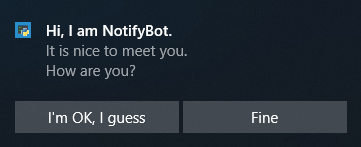Further on templates¶
In previous tutorial, we managed to create a notification from template. In this part, we will make the most from templates.
Multiple lines¶
As I said in previous tutorial, not each zroya.TemplateType supports multiple lines of text. So make
sure you pick the right one - for example zroya.TemplateType.ImageAndText4. You may set up to three lines of
text to it.
# zroya is imported and initialized
template = zroya.Template(zroya.TemplateType.ImageAndText4)
template.setFirstLine("Hi, I am NotifyBot.")
template.setSecondLine("It is nice to meet you.")
template.setThirdLine("How are you?")
zroya.show(template)
At the moment, zroya supports up to three lines - each one is set by it’s own function -
zroya.Template.setFirstLine(), zroya.Template.setSecondLine() and
zroya.Template.setThirdLine().

Notification with three lines of text
Getting the text back¶
Except functions for setting text, there are functions for getting it back from template. They are named
zroya.Template.getFirstLine(), zroya.Template.getSecondLine() and
zroya.Template.getThirdLine() respectively.
We will use template from previous example to get second line back:
print(template.getSecondLine())
#> "It is nice to meet you."
If there is no such text, empty string is returned.
Change sound¶
It is all nice and so, but the sound Windows does when notification is created is sooo boring, right? Let’s change it.
template.setAudio(zroya.Audio.Call4)
Sadly, there is no way to play just any sound you want. You can choose from plenty of sounds defined in
zroya.Audio class. On the other hand, they are available at any Windows station.
If this is not enough, you can play selected sound in loop until the notification is moved to Action Center, or until user dismiss it.
template.setAudio(zroya.Audio.Call4, zroya.AudioMode.Looping)
But I wouldn’t recommend it. On the other hand, muting notifications may be usable a bit more:
template.setAudio(mode=zroya.AudioMode.Silence)
Expiration time¶
Notifications will stay in Action Center until you shut the application off or you manually remove them from there.
But some notifications should have shorter lifespan - for example weather reports. There is no use of the old ones.
Beside hiding them from code, zroya.Template.setExpiration() comes to aid.
template.setExpiration(1000)
It takes a number of milliseconds after which the notification is automatically removed from Action Center.
Images¶
UI is key to user’s heart. Let’s make bot more friendly. Add image with zroya.Template.setImage().
template.setImage("./image.png")

Isn’t he cute :*
At this point, we make use of that zroya.TemplateType.ImageAndText4 template type. For example
with zroya.TemplateType.Text4, this function would return False every time, because it does not support
this type.
Actions¶
One pretty cool feature is adding actions. Those are buttons which can have attached some action to them. When user click them, event is fired. See Callbacks.
In this example, we add two buttons to respond question notification is asking. What a wonderful time, answering your own questions :).
template.addAction("I'm OK, I guess")
template.addAction("Fine")

Answer the question, please.
As you probably noticed, they don’t do much now. Just dismiss it. We will do something about it in the next tutorial.
Troubleshooting¶
Actions fail to be added: Actions are one of Windows 8.1+ features. If you have older system, they won’t work.